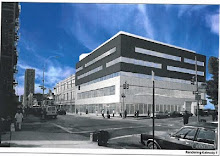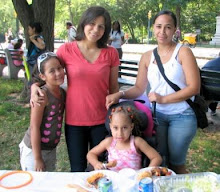
To commemorate our new office space, Sinergia's lobbies on the 3rd and 4th floors of 2082 Lexington Avenue are graced by the works of Samuel Lind, a noted Puerto Rican artist whose creative force captures the African based experience of Puerto Rico. The exhibit, entitled:
Aires de Loiza: Culture and Nature, A Retrospective of the Work of Samuel Lind, is made possible through the generosity of Samuel Lind and the
Caribbean Cultural Center African Diaspora Institute. A very special ¡
muchas gracias! goes to Marta Moreno Vega, Executive Director of CCCAI, and to Dianne Smith, artist and Board member of Sinergia, who will shepherd our gallery space as a place which honors our rich, cultural and artistic heritage and celebrates artists with disabilities as well as community artists. The exhibit is open to the public and will be on view until April 30th, 2010.
 Here's more about the artist:
Here's more about the artist:
Samuel Lind is an artist dedicated to understanding the creative forces that define the African based experience of Puerto Rico. Lind works with a variety of mediums that allow him to capture the images that surround him. Samuel's concern for the well being of his community and preservation of the environment is expressed in the visual dialogue that is actualized within the community of development vs displacement of the poor. These issues are the creative fuel that ignite and frame Samuel Lind’s powerful imagery and question our commitment to the quality of life now and in the future.
"Reflections on my Visual Career"
by Samuel Lind
"My first encounter with graphics was during my adolescence and I immediately felt that it was connected with culture. I admired the artists who were able to characterize people uniting images with written messages on their posters. That was during my first stages of drawing and I had a strong urge to capture peoples’ typical scenes and cultural expressions. I used my sketch pad or any paper I could put my hands on to capture scenes as one would with a camera. Wherever people came together, whether at play, dancing bomba or at the Saint James Festival I would intently bring out what I saw and put it on a poster or a painting.

As a child, I was unfamiliar with the rudiments of making serigraph prints
and my posters were one of a kind, not repeated. My intermediate school teacher noticed my dedication and would provide me the materials that I needed such as construction paper, tempera paints, bottled egg whites, oils, pigments and fixatives to adhere to the paper or cardboard- I would even paint on paper bags that the local grocer would give me. The room I shared with my older brothers looked like a small exhibit hall filled with typical scenes and landscapes. I only needed a board to place my paper and the light that filtered through the trees and that was my work space.
My intermediate school teacher Miss Rosa organized my first exhibit of posters as a part of a cultural activity in the school. The reaction that I received motivated me to continue to pursue art. I learned to make light strokes to bring out the main figure or object, in the second plane were the landscape or the background figures, or sometimes some words that would frame the theme to give a direct message to the spectator. As an adolescent people actually started to buy my works and they would have them framed. That was important to me, it made things feel official, that it was a job as well as a communicative tool with which I could spread a message.
I was exposed to an artistic print workshop when I formally studied at the Fine Arts College of the Institute of Culture. At first I was drawn towards wood block prints, but once I experimented with silkscreening there was more connection with the color. Pressing the ink with the squeegee to pass it through the silk screen provokes a sensation which resembles an act of faith, producing sometimes unexpected results. That lack of certainty, that magic captured me since the first experiment which was printing the primary colors over each other, marking the transparencies and colors produced by layering. It was a phenomenon that I was only able to control with time in my studio, it altered my graphic expression and my thinking.

There was a long standing tradition in Puerto Rico of using prints to promote development and education. Artistic posters were used to educate people in rural areas. Silk screen posters was also frequently used to promote cultural activities and were done by artists contracted by the Institute of Culture’s Office of Community Relations. With time, prints evolved to become an art form that distinguished Puerto Rico in the worldwide art market. I was influenced by three distinguished professors and master artists; José Alicea (Printmaker) Lorens Omar ( Silk Screen Printer) and Augusto Marín (Painter). Even today, I hear their voices at times, when I put down a paint stroke, when I create a print.
My first silk screen print was for the Loíza Festival. It was entitled “Loíza Aldea Noble Town” and the first Bomba dance print was called “Rulé son da” and while I was working Tite Curet Alonso arrived to my studio (distinguished composer and folklorist). While talking with him the idea of doing a poster for an activity in Loíza called “
Las Enramadas” ( The Ranch Sales) which ended up being my first silkscreen poster sponsored by the Puerto Rican Foundation of the Humanities and was prized in 1979.
After that initial start things started to move along and I was contracted by diverse counties and government agencies to make silkscreen prints for different cultural activities, for example, the Industrial Promotion Agency, the Tourism Agency, Theater Festival, among others. I have been especially connected with activities with African roots such as Bomba and Plena festivals. Admittedly, my major motivation to develop my skills as a serigraph printer making the posters for the Saint James Festival of my own town of Loíza. For me it is a long standing tradition and I do my best to print that commemorative poster every year which is also used for the cover of the festival program which are collectibles.

I have been a poor collector of my own prints but I am enthusiastic about the idea of this retrospective because it forced me to restore some of the most important images I have produced. During this process, I discovered that from the first one up until the most recent for the Bomba and Plena Festival of 2007 I have experienced each of the scenes that I have put down. During my humble career as an artist for the last 36 years I must say that the most enriching part has been sharing my work with all kinds of people, humble folks as well as collectors from all parts of the world.
I am grateful to the Creator and all the angels that have assisted me as well as all the people who have appreciated and collected my works in their homes. I am but an anonymous worker of the arts with a mission to express my feelings and thoughts creatively."
 The "No Child Left Behind" Act, which requires states to develop tests in basic skills to be given to all students in certain grades in order to receive federal funds for schools, was signed into law in 2002 and provides the largest amount of funding to schools through Title I. Under the 2002 act, students with disabilities were listed among the five sub-groups schools were required to report performance on.
The "No Child Left Behind" Act, which requires states to develop tests in basic skills to be given to all students in certain grades in order to receive federal funds for schools, was signed into law in 2002 and provides the largest amount of funding to schools through Title I. Under the 2002 act, students with disabilities were listed among the five sub-groups schools were required to report performance on.






















